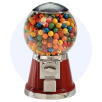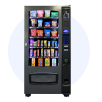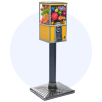FAQ's
Gumball.com FAQs
- What size gumballs do I need?
- What size replacement globe do I need?
- How can I get a replacement key for my machine?
- How do I drill out the lock of my gumball machine?
- Do you have a printed catalog?
- Can a machine be set to "Free Vend" without quarters?
- What is ABS Plastic & why are most machines made of that instead of metal?
- Which machines will dispense fish food or animal pellets?
- How much money will a gumball machine make?
- What is the shelf life of my candy or gumballs?
What size gumballs do I need?
The size of gumballs your machine takes depends on the size of the opening on the gumball wheel that is installed inside your machine. The standard size gumball for a professional grade machine is 1". Carousel machines are meant to vend a .62" or smaller gumballs, however a larger size (up to 1") will vend as well (not recommended as some wiggling of the machine may be required in order to vend the larger size). Check out our handy dandy gumball size chart - click here.
Back to Top
What size replacement globe do I need?
If you have a Carousel machine & are uncertain of which size it is (King, Junior or Petite), simply measure the height of your machine from the base to top cap.
• If the machine is 14"-15" tall, you need a King globe.
• If the machine is 11"-12" tall, you need a Junior globe.
• If the machine is 8"-9" tall, you need a Petite globe.
If you have a professional gumball or candy machine, you will need to order the globe for which ever particular manufactured brand you have (eg: Beaver, Wizard, LYPC).
Back to Top
• If the machine is 14"-15" tall, you need a King globe.
• If the machine is 11"-12" tall, you need a Junior globe.
• If the machine is 8"-9" tall, you need a Petite globe.
If you have a professional gumball or candy machine, you will need to order the globe for which ever particular manufactured brand you have (eg: Beaver, Wizard, LYPC).
How can I get a replacement key for my machine?
If you've misplaced or have broken the key to your gumball machine, you will have to order a replacement key & lock, as they only come as sets*. If you have a universal style lock & key and know the key number, you can specify the key number in the Customer Notes section during the order checkout process. Key numbers are located on the key itself, not on the lock. If you ordered a machine from us, depending on the brand, there is a possibility that we can find your key number.
If you do not know your key number, you will have to drill out your lock and replace the lock and key. It is important that you order the lock and key for the exact machine you own since the locks are not necessarily interchangeable from machine to machine.
*Wizard machine keys are available without the lock assembly's. If you know the key number for you Wizard machine you can order the key only & specify which key number you would like in the Customer Notes section of the order checkout process.
Back to Top
If you do not know your key number, you will have to drill out your lock and replace the lock and key. It is important that you order the lock and key for the exact machine you own since the locks are not necessarily interchangeable from machine to machine.
*Wizard machine keys are available without the lock assembly's. If you know the key number for you Wizard machine you can order the key only & specify which key number you would like in the Customer Notes section of the order checkout process.
How do I drill out the lock of my gumball machine?
Assuming you have a tubular or barrel lock that you need to remove, you will need the following tools:
1. Drill
2. Drill bits - 1/4 inch drill bit and a small sized bite 1/8 inch bit or smaller
3. Masking tape (optional)
4. Ruler (optional)
5. Large screwdriver (optional)
6. Needle nose pliers or vice grips (optional)
Time required is approximately 5 to 10 minutes.
Step #1 - Ensure that you your gumball / candy vending machine is in a stable and secure location for the drilling process. We want to avoid having the machine tipping over and possibly breaking the globe.
Step #2 (optional) - You will be drilling a hole down the center of the lock that is 1/4 inch deep. For each drill bit, use a ruler to measure 1/4 inch depth starting from the tip of the bit. Wrap a piece of tape marking off a 1/4 inch depth on the bit (see photo below). This tape will be your depth guide and will ensure that you don’t drill too deep into the lock causing damage to internal parts your gumball / candy vending machine.
Step #3 - Start with the small drill bit (1/8 inch or smaller), this makes the project go much faster, and bore a starter hole into the center of the lock. Drill approximately 1/4 inch deep (stop drilling when you reach the masking tape).
Step #4 - Finally, using the larger 1/4 drill bit, bore a second large hole through the initial hole, this will destroy the internal parts of the lock and will free it for removal. On your initial attempt try not drill beyond 1/4 inch depth. Thus will usually free up most locks. In some cases you may need to drill a little deeper (1/8 inch) to reach the black pin that holds the lock to the nut. Note: Some locks are stubborn and you may need to insert a screwdriver into the drilled out lock and twist to remove the housing, needle nose pliers can also aid the process. Now you should have access to your gumball / candy vending machine.
Back to Top
1. Drill
2. Drill bits - 1/4 inch drill bit and a small sized bite 1/8 inch bit or smaller
3. Masking tape (optional)
4. Ruler (optional)
5. Large screwdriver (optional)
6. Needle nose pliers or vice grips (optional)
Time required is approximately 5 to 10 minutes.
Step #1 - Ensure that you your gumball / candy vending machine is in a stable and secure location for the drilling process. We want to avoid having the machine tipping over and possibly breaking the globe.
Step #2 (optional) - You will be drilling a hole down the center of the lock that is 1/4 inch deep. For each drill bit, use a ruler to measure 1/4 inch depth starting from the tip of the bit. Wrap a piece of tape marking off a 1/4 inch depth on the bit (see photo below). This tape will be your depth guide and will ensure that you don’t drill too deep into the lock causing damage to internal parts your gumball / candy vending machine.
Step #3 - Start with the small drill bit (1/8 inch or smaller), this makes the project go much faster, and bore a starter hole into the center of the lock. Drill approximately 1/4 inch deep (stop drilling when you reach the masking tape).
Step #4 - Finally, using the larger 1/4 drill bit, bore a second large hole through the initial hole, this will destroy the internal parts of the lock and will free it for removal. On your initial attempt try not drill beyond 1/4 inch depth. Thus will usually free up most locks. In some cases you may need to drill a little deeper (1/8 inch) to reach the black pin that holds the lock to the nut. Note: Some locks are stubborn and you may need to insert a screwdriver into the drilled out lock and twist to remove the housing, needle nose pliers can also aid the process. Now you should have access to your gumball / candy vending machine.
Do you have a printed catalog?
Unfortunately, we do not. Our product line-up expands frequently so it would not be practical to print a catalog.
Back to Top
Can a machine be set to "Free Vend" without quarters?
Yes. If you would like your new vending machine to be set to free spin, be sure to select this option when placing your order online. If you need instructions on how to set the coin mechanism to free spin yourself, send us an email & be sure to tell us what kind of machine you have. We will forward you instructions for your particular machine, if we have them.
Back to Top
What is ABS Plastic & why are most machines made of that instead of metal?
Acrylonitrile butadiene styrene (ABS) is a common thermoplastic used to make light, rigid, molded products such as piping (for example plastic pressure pipe systems), musical instruments, golf club heads (used for its good shock absorbance), automotive body parts, kitchen appliances (such as juicers), and toys. Its melting point is approximately 221°F. The most important mechanical properties of ABS are impact resistance and toughness.
It is industry standard for gumball machine bodies & other components to be made of ABS plastic & there are several advantages of a gumball machine being made of ABS as opposed to metal. The ABS plastic will never chip, as it's not painted. No worries of dents or rust on plastic either, its properties are not affected by temperature and atmospheric humidity!
It is industry standard for gumball machine bodies & other components to be made of ABS plastic & there are several advantages of a gumball machine being made of ABS as opposed to metal. The ABS plastic will never chip, as it's not painted. No worries of dents or rust on plastic either, its properties are not affected by temperature and atmospheric humidity!
* While acrylonitrile, butadiene, and styrene; components in ABS, are listed separately on California’s Proposition 65 list of chemicals that it has determined cause cancer and/or reproductive effects, the compound ABS is not listed.
Back to Top
Which machines will dispense fish food or animal pellets?
Any of our machines with candy dispensing wheels would work just fine. Many of our customers have used our machines to dispense fish and animal food at petting zoos and koi ponds. Please note, however, that the machines are not built for outside use and are not weather-proof. If you do use the machines outdoors, we would recommend installing a shelter for the machines to protect them from the elements.
Back to Top
How much money will a gumball machine make?
Revenue varies from machine to machine. The success of your machine will be dependent upon one key factor: location. The higher the traffic area & the right kind of clientele for the product you're vending, the more product you will sell. The products themselves have different rates of return. Gumballs will typically have the highest rate of return.
Example: one case of gumballs will make $220 in profit?
Here's how...
- Buy one case of gumballs (1080 pieces) = $50 product cost
- Sell one case of gum or 1,080 pieces x 25 cents each = $270 revenue
Example: one case of gumballs will make $220 in profit?
Here's how...
- Buy one case of gumballs (1080 pieces) = $50 product cost
- Sell one case of gum or 1,080 pieces x 25 cents each = $270 revenue
- $270 revenue - $50 product cost = $220 Profit in your pocket
Back to Top
What is the shelf life of my candy or gumballs?
Different types of candy have different shelf lives. Gumballs have a shelf life of 24 months & candy will have a shelf life of at least 18 months. To maximize shelf life, store the candy unopened in a cool (but not refrigerated) and dry place. We suggest you purchase your gum or candy no more than 2 months prior to its use.
Back to Top
Do you have a Blog?
Yes, click the following link to access our blog or the latest industry news.




